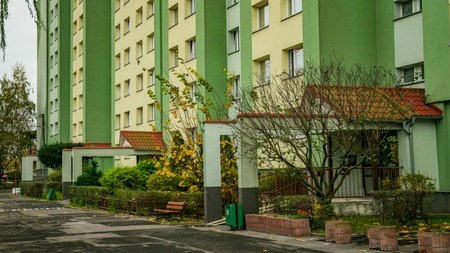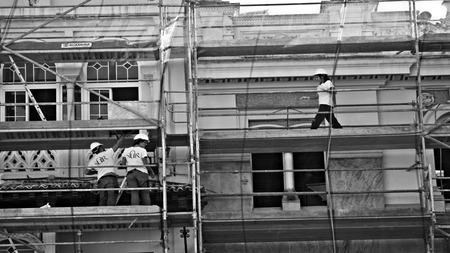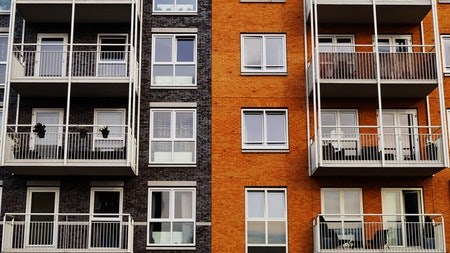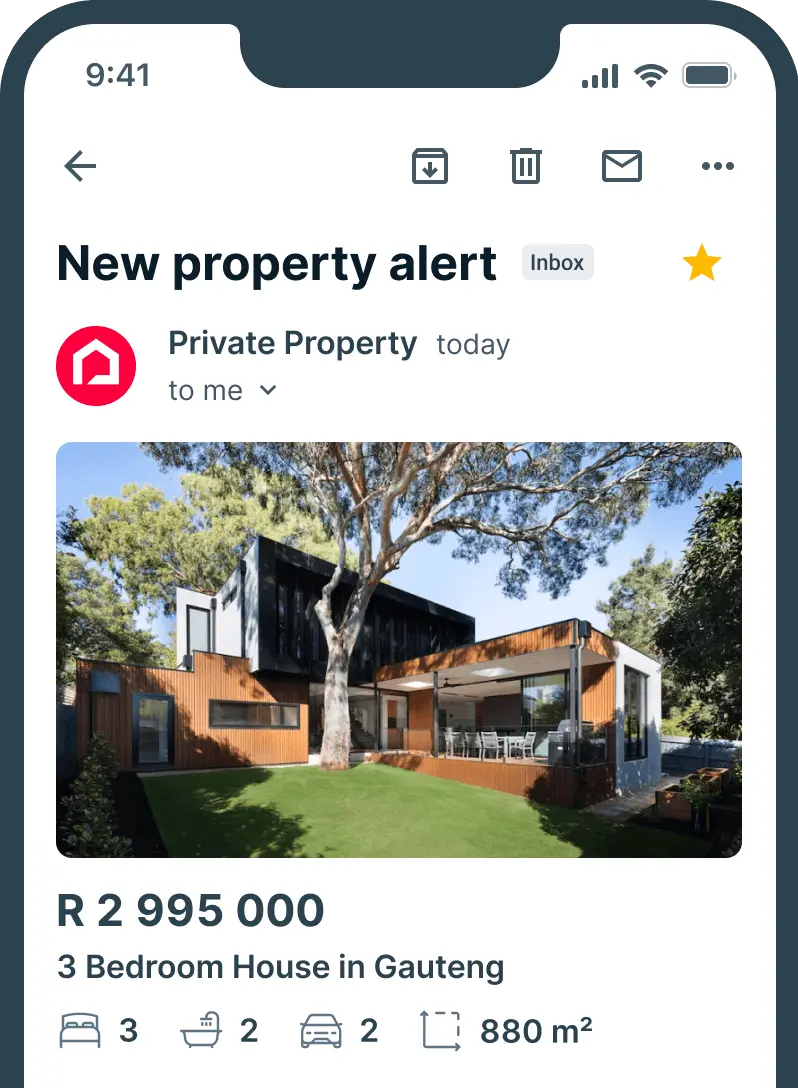Shared Spaces, Shared Costs - Who is Responsible for Maintenance and Repairs in Sectional Title Schemes?
Sectional Title Solutions
The upkeep of shared spaces in sectional title schemes is essential for the benefit of the entire community. When buyers purchase a unit within a sectional title scheme, it often comes with amenities which can include items such as 24-hour security, swimming pools, shared gardens, and other recreational areas, as well as solar and battery storage facilities. Owners are often unaware of who is responsible for the maintenance and repair costs for a particular item should something go wrong, which we aim to clarify in the article below.
Legislation governing sectional title schemes
Firstly, it is important to note the legislation that governs sectional title schemes within South Africa and that will be referenced in this article. This legislation includes the following:
Secondly, before one looks at specific items and the question of who is responsible for the costs of maintenance and repair, one needs to understand how this legislation may apply to the different parts of a sectional title scheme.
| PART |
DESIGNATION |
| Primary Sections |
- Defined in Regulation 1 of the STSMA Regulations.
- Intended for human occupation.
- Examples: a residence, office, shop, factory or for any other type of use allowed in terms of local municipal by-laws.
|
| Utility Sections |
- Defined in Regulation 1 of the STSMA Regulations.
- In terms of local municipal by-laws, designed to be used as an accessory to a primary section.
- Examples: a parking garage or a storeroom.
|
| Common Property |
- Defined in section 1 of the STA and STSMA.
- Consists of all land and the buildings, or part thereof, in the scheme which are not primary or utility sections.
- Collectively owned by all unit owners in undivided shares, with each owner's share corresponding to the size of their respective section.
|
| Exclusive Use Areas ("EUAs") |
- Defined in section 1 of STA and STSMA.
- EUAs are portions of the common property set aside for the exclusive use of one or more unit owners or occupiers.
- The holders of exclusive use rights typically have the sole right to use and enjoy a specific portion of the common property. This right allows the holder to occupy and use that specific area, such as a garden, yard, or parking space, without interference from other unit owners or occupiers.
|
Thirdly, it is also important to have a clear understanding of the boundaries between a section (either a primary or utility section), other sections, and common property, which the STA refers to as the median line. This understanding is necessary as it usually depends on what side of the median line the necessary work is required when it comes to determining responsibility for maintenance and related expenses.
Section 5(4) of the STA specifically refers to the median line as "The common boundary between any section and another section or common property shall be the median line of the dividing floor, wall or ceiling, as the case may be." In other words, when two sections share a boundary, or when a section shares a boundary with common property, the median line is considered to be the middle line between the floor, wall, or ceiling that separates them.
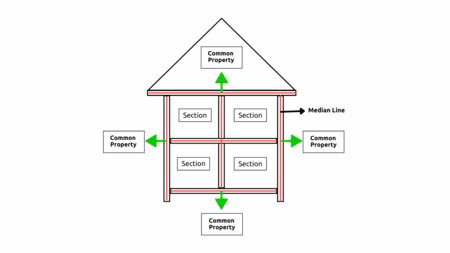
Responsibility for maintenance and repairs
Now that the basics have been covered, the below table provides a broad overview of the parties who are usually responsible for costs and maintenance required to be undertaken within a sectional title scheme.
| AREAS |
RESPONSIBILITY |
| Foundations |
- The area below the median line of the floor of the building is common property.
- Foundations are common property as they are below the median line of the floor and therefore the responsibility of the body corporate.
|
| Roof |
- The area above the median line of the ceiling (of the uppermost units in multi-storey buildings) is common property.
- The roof is common property as it is above the median line of the ceiling and therefore the responsibility of the body corporate.
- However, look out for the unique scenario relating to geysers below.
|
| Windows, Doors and Other Structures |
- Section 5(5)(a) of the STA provides that any window, door or other structure which is part of a shared boundary which separates sections, or a section and common property will be considered to form part of such floor, wall or ceiling.
- If these items are part of a shared boundary which separates two sections, the maintenance and repair costs are usually shared equally between the unit owners.
- If these items are part of a shared boundary which separates a section and common property, the maintenance and repair costs are usually shared equally between the unit owner and the body corporate.
- Shared boundaries are usually clearly defined in the sectional plans and can be easily determined.
|
| Other Structures -- Part Two |
- When defining the boundaries of a section (like a unit in a building), the usual rule is to use the floors, walls, and ceilings to show where the section starts and ends.
- However, as per section 5(5)(b) of the STA, there are some parts of a section, like a porch, balcony, or any other area that sticks out from the main part of the section, where it's hard to define the boundaries using just the floors, walls, and ceilings.
- In these cases, if this "extra" part (like the balcony) belongs to a section that can be easily defined using floors, walls, and ceilings, then the boundaries of the balcony or similar area will be defined as per the sectional plan.
- The sectional plan will sometimes delineate a balcony, or porch as being fully part of the section from which it projects, or as being common property but with an exclusive use right to the owner of the section. The responsible party for costs of maintenance and repair will depend on how the sectional plan has delineated the area and the applicable rules.
|
| Exclusive Use Areas ("EUAs") |
- The terms relating to the use and enjoyment of the EUA are usually contained in the written instrument that confers the right of exclusive use to that part of the common property (i.e. a notarial deed of cession or rule). However, there is generally a shared responsibility for the costs pertaining to EUAs between the body corporate and the holder of the right to exclusive use.
- Section 3(1)(c) of the STSMA requires the body corporate to ensure that owners who enjoy the exclusive use of a part of the common property make additional contributions to cover costs such as rates, taxes, insurance, and maintenance for that area (whether this right is registered or granted by rules). This also includes costs for electricity and water, unless the rules say the owners are already responsible for these expenses.
- Section 13(1)(c) of the STSMA requires owners who have exclusive use of a part of the common property, to keep it in a clean and neat condition.
|
| Security |
- Responsibility lies with the body corporate for the costs associated with the repair and maintenance of all security items such as common property cameras and common property gates which are placed at the entrance and on the perimeter of the scheme and common property.
- PCR 4 of the STSMA Regulations provides that a unit owner or occupier is automatically considered to have the trustees' permission to install a lock or safety device to protect against intruders, or a screen to keep out animals or insects, as long as the device or screen is well-made and matches the design, colour, style, and materials approved in writing by the trustees. The owner or occupier of a section must keep device installed, such as those described above, in good order and repair.
- While not specifically stated this wording the PCR seems to indicate that if a unit owner decides to electively install such safety device it would be for their own account.
|
| Pest Control |
- This is generally the responsibility of the body corporate in terms of common property that does not form part of an EUA.
- A unit owner is responsible for pest control within their specific area or part of the common property to which they have exclusive use rights as per PCR 8 of the STSMA Regulations.
- However, it is arguable that if the pest infestation originated on, or from common property, in certain circumstances, the body corporate may be responsible for covering all of the costs of removing the pests that have entered a section and caused harm or damage or may cause such harm or damage.
|
| Geysers |
- The maintenance and repair of a geyser remains the responsibility of a unit owner. This is in accordance with PMR 31(1) of the STSMA Regulations. Sometimes the body corporate includes the insurance of geysers on the insurance schedule with the body corporate's insurers.
- Geysers are located above the median line, and while the body corporate remains liable for events such as a burst geyser, any work that needs to be undertaken as a result of lack of maintenance of the geyser itself, pipes or other related apparatus, remains for the owner's account.
|
| Water Leaks |
- The body corporate remains responsible for the repairs of water leaks originating from the roofs as these roofs are located above the median line in the ceiling and are considered common property.
- However, a slab which separates a top and bottom unit may not be common property and any repair and maintenance thereof may not be the responsibility of the body corporate.
- The median line running through the middle of the slab usually separates the bottom unit from the top into two sections, with the area above the line being the responsibility of the owner of the top section, and the area below the line, that of the owner of the bottom section.
- However, if a unit experiences damage from a leak caused as a result of a leaking pipe, shower or bath caused as a direct result of a leak originating from the top unit, then the top section owner may be liable for maintenance and repair costs for damages in the bottom section as the leak emanated from their section.
- Where damages are caused to a unit as a result of water ingress from common property, the responsibility lies with the body corporate.
- Furthermore, the body corporate is responsible where a water pipe within a wall supplies more than one section or the common property.
- A unit owner however remains responsible for any water pipe that supplies hot water to a section as well as if a leak between sections results in damage, the owner of the section from which the leak originates may be responsible for the costs.
|
| Solar Panels |
- The responsibility for maintaining solar installations in schemes largely depends on the underlying contract with the installer or owner of such installations, particularly when it comes to common property, such as roofs or carports.
- Generally, the body corporate is responsible for maintaining common property, but this can vary depending on ownership of the solar facilities.
- For instance, with Bright Light's Solar and Battery Storage Solutions, Bright Light maintains the solar panels, inverter, and related components if it owns them. However, if the solar facilities are purchased from Bright Light or another provider and are considered common property, then the other principles discussed in this article regarding who bears the cost may apply.
- Understanding the specifics of the applicable contract and ownership is essential in determining maintenance and repair responsibilities.
|
Administrative and reserve funds
Lastly, a prospective owner must be aware that in terms of section 3(1) of the STSMA the body corporate is required to establish an administrative fund as well as a reserve fund. And a prospective owner must also understand why levies (also referred to as "contributions") are payable by each owner.
The reserve fund is established and maintained to cover the cost of future maintenance and repair of the common property, and the amounts required are calculated in terms of Regulation 2 of the STSMA Regulations. The reserve fund must be used to implement the 10-year maintenance, repair and replacement plan for major capital items which is required in terms of PMRs 22 read with 24(2).
A major capital item is defined in the PMRs as "wiring, lighting and electrical systems, plumbing, drainage and storm-water systems, heating and cooling systems, any lifts, any carpeting and furnishings, roofing, interior and exterior painting and waterproofing, communication and service supply systems, parking facilities, roadways and paved areas, security systems and facilities and any other community and recreational facilities."
The amount payable by an owner in respect of the maintenance, repair and replacement plan will be specific to any particular scheme and can vary largely depending on the scheme's major capital items, and ongoing compliance with the minimum threshold determined for the reserve fund in terms of Regulation 2 of the STSMA Regulations.
The administrative fund must be used to fund the operating expenses of the body corporate for a particular financial year and should include provision for:
- the repair, maintenance, management and administration of the common property (including reasonable provision for future maintenance and repairs);
- the payment of rates and taxes and other local municipality charges for the supply of electricity, gas, water, fuel and sanitary or other services to the building or land;
- the payment of any insurance premiums relating to the building or land; and
- the discharge of any duty or fulfilment of any other obligation of the body corporate.
A prospective owner will only have a full understanding of what other duties and/or responsibilities there may be on a proper analysis of the body corporate's budget but should usually include items such as managing agent's fees and provision for legal fees for collection of outstanding levies.
The unit owners, as the body corporate must work together collectively to uphold the integrity and of their community. Failing to maintain shared spaces can undermine the property value and harmony of a sectional title scheme. In both cases, collective responsibility and accountability is key to ensuring long-term protection and prosperity.
At Sectional Title Solutions, we provide arrear levy and project finance solutions and facilities, designed to meet your specific body corporate and/or HOA needs. In need of urgent repairs and maintenance for your scheme but don’t have the funds? Don’t let your budget throw a spanner in the works, we are ready to help you with a tailored funding solution, ensuring your scheme thrives in a complex economic environment.
Need assistance? Click here to get in touch.
While this article offers general guidance, it is crucial to understand that specific circumstances can significantly influence responsibility and liability within schemes. In complex or ambiguous situations, we strongly recommend reaching out to our advisory desk for tailored assistance.
Contextual factors often play a pivotal role in determining who bears the costs or responsibilities in any given scenario, and the principles discussed here, while broadly applicable, may not cover every unique case. Individual circumstances may lead to different outcomes, so personalised advice is essential for navigating these complexities effectively and reaching a fair and accurate outcome.

